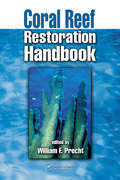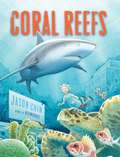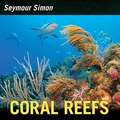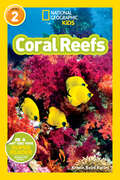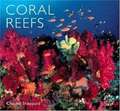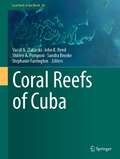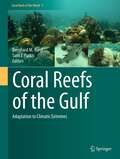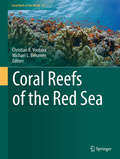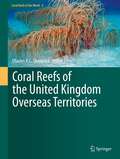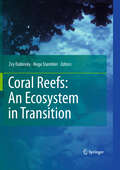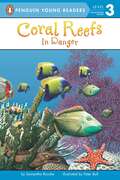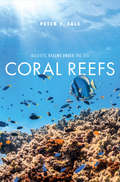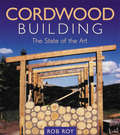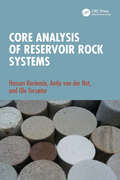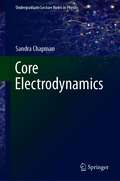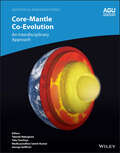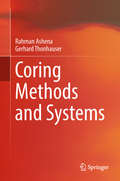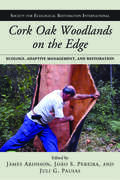- Table View
- List View
Coral Reef Restoration Handbook
by William F. Precht" this book is the first to describe, in detail, the art and science of coral reef restoration. It is to be hoped that the information that can be gleaned within the pages of this book will set a path towards continued preservation of this valuable underwater treasure to be used, appreciated, and experienced for future generations."-- Senator
Coral Reefs
by Jason ChinVenture to the depths of the coral reefs in an exploration of the true and truly wild in this follow-up to the stellar Redwoods. During an ordinary visit to the library, a girl pulls a not-so-ordinary book from the shelves. As she turns the pages in this book about coral reefs, the city around her slips away and she finds herself surrounded by the coral cities of the sea and the mysterious plants and animals that live, hunt, and hide there. Image descriptions present.
Coral Reefs
by Seymour SimonSeymour Simon knows how to explain science to kids and make it fun. He was a teacher for more than twenty years, has written more than 250 books, and has won multiple awards. <P><P>In Coral Reefs, Simon introduces elementary-school readers to the oceans’ reefs through wonderful descriptions and stunning full-color photographs. He encourages appreciation of the ecology of coral reefs, explains why they are in danger, and suggests ways kids can help save the endangered reefs. Lexile Measure: NC1110L
Coral Reefs (Readers)
by Kristin Baird RattiniIn this level 2 reader, young readers explore the amazing underwater world of coral reefs. Beautiful photos and carefully leveled text make this book perfect for reading aloud and for independent reading.
Coral Reefs (WorldLife Library)
by Charles SheppardCoral reefs are one of the wonders of the natural world. Protecting thousands of miles of shoreline from erosion, these intricate structures support biodiversity essential to the balance of the world's ecosystems. They are one of nature's most significant and ancient infrastructures. Global warming and our overuse of the reefs is causing untold damage to these beautiful yet fragile formations. In this lavishly illustrated book, Dr. Charles Sheppard explores the underwater world of coral reefs. Using popular examples from around the world, he explains how these vast constructs function and what must be done to save them.
Coral Reefs of Cuba (Coral Reefs of the World #18)
by Vassil N. Zlatarski John K. Reed Shirley A. Pomponi Sandra Brooke Stephanie FarringtonThis comprehensive volume gathers foremost experts on the coral reefs of Cuba who represent a spectrum of disciplines, including biology, conservation ecology, economics and geology. The volume is organized along general themes including the Cuban Reef biota, reefs occurring in the Mesophotic and Eutrophic zones, ecology, conservation, management and the economic importance of the coral reefs of Cuba. The combination of case studies, new and previously published research, historical overview and examples of the ways in which research has contributed to the management and conservation of Cuban coastal resources provides a unique reference for graduate students and professionals holding a wide range of interests and expertise related to coral reef systems.
Coral Reefs of Singapore's Urbanised Sea (Coral Reefs of the World #23)
by Loke Ming Chou Danwei HuangThis book highlights how Singapore&’s coral reef system is responding to changing environmental conditions caused by urbanization and climate change. It provides a fundamental understanding of how reefs respond to decades of chronic urbanization impacts and episodic marine heatwave events, with studies revealing responses at molecular, cellular, organismal, and community levels. Knowing what drives the persistence of coral-dominated reefs through urbanization and global warming impacts will contribute to the formulation of effective conservation strategies. The chapters cover topics such as the impacts of sedimentation on coral communities, the energetic needs of corals in extreme environments, and the diversity of Symbiodiniaceae dinoflagellates. Readers will discover insights into the resilience of coral reefs, the role of microbiomes, and the thriving coral reef fishes in Singapore&’s urban reef system. This literature invites readers to think through critical questions about conservation status and biological connectivity in urbanized seascapes. Contributions from distinguished scholars and practitioners provide expert insights into theoretical frameworks and practical case studies, addressing topics such as the impacts of climate change, the persistence of coral-dominated reefs in the face of substantial losses and bleaching events, and strategies for management and reef restoration initiatives. Researchers, ecologists, and reef managers will find this book invaluable. It offers a comprehensive analysis of Singapore&’s coral reefs, making it essential for anyone interested in marine conservation, urban ecology, and sustainable development. This volume is a crucial resource for understanding and managing coral reef resilience in the face of urbanization and climate change. Scholars, students, and practitioners in marine biology, environmental science, and urban planning will benefit from the insights and strategies presented. As governments seek to fulfil obligations to COP and UN Sustainable Development Goal 14, this book provides the scientific foundation needed to guide effective conservation measures in tropical coastal cities.
Coral Reefs of the Gulf: Adaptation to Climatic Extremes (Coral Reefs of the World #3)
by Sam J. Purkis Bernhard M. RieglCoral Reefs of the Gulf: Adaptation to Climatic Extremes is a complete review and reference for scientists, engineers and students concerned with the geology, biology or engineering aspects of coral reefs in the Middle East. It provides for the first time a complete review of both the geology and biology of all extant coral areas in the Gulf, the water body between Iran and the Arabian Peninsula. In summer, this area is the hottest sea with abundant coral growth on earth and already today exhibits a temperature that is predicted to occur across the topical ocean in 2100. Thus, by studying the Gulf today, much can be learned about tomorrow's world and the capability of coral reefs to adapt to climatic extremes. This volume provides the most authoritative and up-to-date review of the coral reefs in the Gulf. It can be used as a volume of general reference or as a textbook treating recent coral reefs. Written by local and international experts, the text is richly illustrated and will remain a standard reference for the region for decades to come. Contributions stretch from climatology through geology, biology, ecological modelling and fisheries science to practical conservation aspects. The book is useful for the technical expert and casual reader alike.
Coral Reefs of the Red Sea (Coral Reefs of the World #11)
by Christian R. Voolstra Michael L. BerumenThis volume is a complete review and reference work for scientists, engineers, and students concerned with coral reefs in the Red Sea. It provides an up-to-date review on the geology, ecology, and physiology of coral reef ecosystems in the Red Sea, including data from most recent molecular studies. The Red Sea harbours a set of unique ecological characteristics, such as high temperature, high alkalinity, and high salinity, in a quasi-isolated environment. This makes it a perfect laboratory to study and understand adaptation in regard to the impact of climate change on marine ecosystems. This book can be used as a general reference, guide, or textbook.
Coral Reefs of the United Kingdom Overseas Territories (Coral Reefs of the World)
by Charles R.C. SheppardThe tropical UK Territories have extensive coral reefs. Huge parts of these areas are exceptionally rich, productive and diverse. Their marine biodiversity exceeds that of the UK itself, and several are already, or are planned to be, strictly protected. Some of these areas serve as reference sites for many other countries with damaged reefs and they are oases of tropical marine biodiversity in a fast-degrading world. This book reviews all of the UK reefs, from those scarcely known to those where substantial research has already been performed.
Coral Reefs: An Ecosystem In Transition
by Zvy Dubinsky Noga StamblerThis book covers in one volume materials scattered in hundreds of research articles, in most cases focusing on specialized aspects of coral biology. In addition to the latest developments in coral evolution and physiology, it presents chapters devoted to novel frontiers in coral reef research. These include the molecular biology of corals and their symbiotic algae, remote sensing of reef systems, ecology of coral disease spread, effects of various scenarios of global climate change, ocean acidification effects of increasing CO2 levels on coral calcification, and damaged coral reef remediation. Beyond extensive coverage of the above aspects, key issues regarding the coral organism and the reef ecosystem such as calcification, reproduction, modeling, algae, reef invertebrates, competition and fish are re-evaluated in the light of new research and emerging insights. In all chapters novel theories as well as challenges to established paradigms are introduced, evaluated and discussed. This volume is indispensible for all those involved in coral reef management and conservation.
Coral Reefs: In Danger (Penguin Young Readers, Level 3)
by Samantha BrookeDid you know that coral is actually a living creature? That the world's most famous coral reef, the Great Barrier Reef, is so big that astronauts can see it from outer space? Kids will love learning fun facts about coral reefs, the beautiful fish who make it their home, and why these amazing habitats are in danger.
Coral Reefs: Majestic Realms under the Sea
by Peter F. SaleAn eye-opening introduction to the complexity, wonder, and vital roles of coral reefs When mass coral bleaching and die†‘offs were first identified in the 1980s, and eventually linked to warming events, the scientific community was sure that such a dramatic and unambiguous signal would serve as a warning sign about the devastating effects of global warming. Instead, most people ignored that warning. Subsequent decades have witnessed yet more degradation. Reefs around the world have lost more than 50 percent of their living coral since the 1970s. In this book, distinguished marine ecologist Peter F. Sale imparts his passion for the unexpected beauty, complexity, and necessity of coral reefs. By placing reefs in the wider context of global climate change, Sale demonstrates how their decline is more than simply a one†‘off environmental tragedy, but rather an existential warning to humanity. He offers a reframing of the enormous challenge humanity faces as a noble venture to steer the planet into safe waters that might even retain some coral reefs.
Corals (Nature's Children)
by Rob HoustonDescribes the physical characteristics, habits, and natural environment of corals.
Corals of Florida and the Caribbean
by George F. WarnerPresenting a stunning array of beauty and biodiversity, the coral reefs of Florida and the Caribbean are part playground, part research lab for the thousands of tourists, divers, and marine scientists who visit them every year. Documenting the wide array of corals at home in the warm waters of the Caribbean, George Warner's Corals of Florida and the Caribbean provides an easy-to-use (and carry) guidebook that is both scientifically accurate and reader friendly.Warner provides an exhaustive identification guide that will enrich any novice's vacation dive or an expert's return to the reefs. Written for the amateur naturalist, this handbook will travel well throughout the Caribbean, from Florida south to Belize, east to Tobago, and all points in between.Beyond documenting the wide variety of corals found in the Caribbean, Warner also outlines their biology, from the way they grow to their reproductive habits, while examining major threats to the reefs including hurricanes, pollution, and global warming. With over 150 color photos, most taken by the author himself, as well as detailed descriptions, Corals of Florida and the Caribbean makes identifying and learning about corals hassle free--on the boat, at home, or in the classroom.
Cordwood Building
by Rob RoyCordwood masonry is an ancient building technique whereby walls are constructed from "log ends" laid transversely in the wall. It is easy, economical, aesthetically striking, energy-efficient, and environmentally sound.Cordwood Building collects the wisdom of more than 25 of the world's best practitioners, detailing the long history of the method, and demonstrating how to build a cordwood home using the latest and most up-to-date techniques, with a special focus on building code issues.Author/editor Rob Roy has been building, researching, and teaching about cordwood masonry for 25 years and, with his wife, started Earthwood Building School in 1981. He has written 10 books on alternative building, presented four videos--including two about cordwood masonry--and has taught cordwood masonry all over the world.
Core Analysis of Reservoir Rock Systems
by Hassan Karimaie Antje van der Net Ole TorsæterCore analysis is an essential source of quantitative data on reservoir properties. These data are used for modeling the distribution and flow of oil and gas reservoirs, CO2 and hydrogen storage, and flow behavior in geothermal reservoirs. While several books cover core analysis for practitioners, this book fills a gap through introducing laboratory equipment and procedures used in core analysis and the theoretical aspects of the parameters. It offers detailed instructions on experimental execution for those with limited or no experience including risk analysis for high safety. Emphasizes the basic characterization of porous materials for multiphase flow, specifically consolidated natural materials Features methods commonly used in the special core analysis within the oil and gas industry, extending to the emerging field of gas storage with occasional references to research-oriented equipment Offers detailed descriptions of laboratory exercises and instructions on data analysis suitable for student work Includes solutions to some exercises to demonstrate the application of measured parameters in reservoir evaluation Provides a unique combination of brief discussions on the basic theory of parameters, explanations of experimental principles, detailed experimental procedures according laboratory standards, and data analysis, with multiple laboratory-related example problems This concise and practical workbook is written for everyone interested in practical measurements of parameters needed for analysis of fluid flow in porous media, specifically students, or for starting staff in the laboratory, preferably with a background in geosciences or fluid mechanics or related topics.
Core Electrodynamics (Undergraduate Lecture Notes in Physics)
by Sandra ChapmanThis book is intended to engage the students in the elegance of electrodynamics and special relativity, whilst giving them the tools to begin graduate study. Here, from the basis of experiment, the authors first derive the Maxwell equations and special relativity. Introducing the mathematical framework of generalized tensors, the laws of mechanics, Lorentz force and the Maxwell equations are then cast in manifestly covariant form. This provides the basis for graduate study in field theory, high energy astrophysics, general relativity and quantum electrodynamics. As the title suggests, this book is “electrodynamics lite”. The journey through electrodynamics is kept as brief as possible, with minimal diversion into details, so that the elegance of the theory can be appreciated in a holistic way. It is written in an informal style and has few prerequisites; the derivation of the Maxwell equations and their consequences is dealt with in the first chapter. Chapter 2 is devoted to conservation equations in tensor formulation; here, Cartesian tensors are introduced. Special relativity and its consequences for electrodynamics are introduced in Chapter 3 and cast in four-vector form, and here, the authors introduce generalized tensors. Finally, in Chapter 4, Lorentz frame invariant electrodynamics is developed. Supplementary material and examples are provided by the two sets of problems. The first is revision of undergraduate electromagnetism, to expand on the material in the first chapter. The second is more advanced corresponding to the remaining chapters, and its purpose is twofold: to expand on points that are important, but not essential, to derivation of manifestly covariant electrodynamics, and to provide examples of manipulation of cartesian and generalized tensors. As these problems introduce material not covered in the text, they are accompanied by full worked solutions. The philosophy here is to facilitate learning by problem solving, as well as by studying the text. Extensive appendices for vector relations, unit conversion and so forth are given with graduate study in mind.
Core Samples: A Climate Scientist's Experiments in Politics and Motherhood
by Anna Farro HendersonPeople live by their stories—how can we use them to accelerate action on climate change? Climate scientist and policy expert Anna Farro Henderson embarks on a remarkable narrative journey in Core Samples, exploring how science is done, discussed, legislated, and imagined. Through stories both raucous and poignant—of far-flung expeditions, finding artistic inspiration in research, and traversing the systemic barriers women and mothers face in science and politics—she brings readers into the daily rhythms and intimacies of scientific research and political negotiation. Grounded in her experiences as a climate scientist, an environmental policy advisor to Minnesota Senator Al Franken and Governor Mark Dayton, and a constant juggler of the many roles and responsibilities of professional moms, Henderson&’s eclectic, unconventional essays range from observations, confessions, and meditations on lab and fieldwork to a packing list for a trip to the State Capitol and a lactation diary. Readers are invited on voyages as far afield as the Trinity nuclear test site in New Mexico, the Juneau Icefield in Alaska, and a meteor crater in Ghana—and as close to home as a town hall meeting in America&’s corn belt. A love letter to science and a bracing (and sometimes hilarious) portrait of the many obstacles women, mothers, and people digging for truth navigate, Core Samples illuminates the messy, contradictory humanity of our scientific and political institutions. Bringing us behind the closed doors of discovery and debate, Henderson exposes the flaws in research institutions, the halls of government, and the role of science in policy, yet she shows how each crack is also an invitation for camaraderie, creativity, and change.
Core-Mantle Co-Evolution: An Interdisciplinary Approach (Geophysical Monograph Series)
by George Helffrich Takashi Nakagawa Taku Tsuchiya Madhusoodhan Satish‐KumarCore-Mantle Co-Evolution An Interdisciplinary Approach The Earth’s deep interior is difficult to study directly but recent technological advances have enabled new observations, experiments, analysis, and simulations to better understand deep Earth processes. Core-Mantle Co-Evolution: An Interdisciplinary Approach seeks to address some of the major unsolved issues around the core-mantle interaction and co-evolution. It provides the latest insights into dynamics, structure, and evolution in the core-mantle boundary region. Volume highlights include: Latest technological advances in high pressure experiments and their application to understanding the mineral physical properties and stability of phases in deep Earth Recent progress in observational seismology, geochemical analysis, geoneutrino experiments, and numerical modeling for understanding the heterogeneity of the lower mantle Theoretical investigations on thermal-chemical evolution of Earth’s mantle and core Exploring thermal-chemical-mechanical-electromagnetic interactions in the core-mantle boundary regions The American Geophysical Union promotes discovery in Earth and space science for the benefit of humanity. Its publications disseminate scientific knowledge and provide resources for researchers, students, and professionals.
Coring Methods and Systems
by Gerhard Thonhauser Rahman AshenaThis book is a practical guide to downhole rock sampling and coring concepts, methods, systems, and procedures for practitioners and researchers. Its chapters are based upon years of extensive studies and research about the coring methods and via direct and continuous communication and consultation obtained from various service and operator companies such as Baker Hughes GE, NOV, OMV, and Sandvik. The contributors discuss the state-of-the-art coring methods and systems (mainly used in the petroleum industry), which include: · conventional coring; · wireline continuous coring; · invasion mitigation coring (low invasion, gel coring, sponge coring); · jam-detection, anti-jamming, full closure; · safe-coring and tripping; · oriented-coring; · pressure/in-situ coring; · logging-while-coring; · motor coring; · mini-coring; · coiled Tubing Coring; and · underbalanced coring. The contributors provide practical and applicable understanding of the procedures of these coring methods and systems, as well as the specific core barrel components, working mechanisms, and schematics of the tools and processes used. Because Coring Methods and Systems analyses and compares the core barrels used in both petroleum and mining industries, it enhances the communication and may allow knowledge transfer between the two industries. As core damage is a serious issue during coring and handling jeopardizing correct calibration of exploration data, Coring Methods and Systems has greatly focused on its identification and its mitigation. Therefore, it can be used as an ideal source for geologists, core analysts, and reservoir engineers, to ensure the retrieval of high-quality cores.
Cork Oak Woodlands on the Edge: Ecology, Adaptive Management, and Restoration (Science Practice Ecological Restoration)
by Juli G. Pausas James Aronson João Santos PereiraCork oak has historically been an important species in the western Mediterranean--ecologically as a canopy or "framework" tree in natural woodlands, and culturally as an economically valuable resource that underpins local economies. Both the natural woodlands and the derived cultural systems are experiencing rapid change, and whether or not they are resilient enough to adapt to that change is an open question. Cork Oak Woodlands on the Edge provides a synthesis of the most up-to-date, scientific, and practical information on the management of cork oak woodlands and the cultural systems that depend on cork oak. In addition, Cork Oak Woodlands on the Edge offers ten site profiles written by local experts that present an in-depth vision of cork oak woodlands across a range of biophysical, historical, and cultural contexts, with sixteen pages of full-color photos that illustrate the tree, agro-silvopastoral systems, products, resident biodiversity, and more. Cork Oak Woodlands on the Edge is an important book for anyone interested in the future of cork oak woodlands, or in the management of cultural landscapes and their associated land-use systems. In a changing world full of risks and surprises, it represents an excellent example of a multidisciplinary and holistic approach to studying, managing, and restoring an ecosystem, and will serve as a guide for other studies of this kind.
Cornish Clouds and Silver Lining Skies: Your no. 1 sunny, feel-good read for the summer
by Ali McNamaraMeteorologist Sky Matthews does not like surprises.Sky monitors her life like she does the weather, carefully and with a scientific eye. So, when she misses out on her dream job abroad and finds herself with no choice but to take a position on a tidal island off the Cornish harbour town of St Felix instead, she feels completely at sea. Worse still, she has to work alongside TV weatherman Sonny Samuels, who barely knows his storms from his tsunamis.It doesn't take long for Sky to become enchanted by the strange weather patterns over St Felix. Sonny is convinced they link to local folklore, but Sky knows her science too well to fall for that. Until she meets Walter, a local weather watcher with no qualifications beyond a lifetime of experience and Sky is forced to question everything she thought she knew about the weather, herself... and Sonny._______________Praise for Ali McNamara:An enchanting escape. Pure magic!' Heidi Swain'A perfect, sparkling, summer read.' Cathy Bramley'Fun and endearing' Katie Fforde'Perfect easy reading' SunAn irresistible, feel-good story infused with infectious humour' Miranda Dickinson'Funny and light-hearted' Heat
Cornish Clouds and Silver Lining Skies: Your no. 1 sunny, feel-good read for the summer
by Ali McNamaraMeteorologist Sky Matthews does not like surprises.Sky monitors her life like she does the weather, carefully and with a scientific eye. So, when she misses out on her dream job abroad and finds herself with no choice but to take a position on a tidal island off the Cornish harbour town of St Felix instead, she feels completely at sea. Worse still, she has to work alongside TV weatherman Sonny Samuels, who barely knows his storms from his tsunamis.It doesn't take long for Sky to become enchanted by the strange weather patterns over St Felix. Sonny is convinced they link to local folklore, but Sky knows her science too well to fall for that. Until she meets Walter, a local weather watcher with no qualifications beyond a lifetime of experience and Sky is forced to question everything she thought she knew about the weather, herself... and Sonny._______________Praise for Ali McNamara:An enchanting escape. Pure magic!' Heidi Swain'A perfect, sparkling, summer read.' Cathy Bramley'Fun and endearing' Katie Fforde'Perfect easy reading' SunAn irresistible, feel-good story infused with infectious humour' Miranda Dickinson'Funny and light-hearted' Heat
Cornish Clouds and Silver Lining Skies: Your no. 1 sunny, feel-good read for the summer
by Ali McNamaraMeteorologist Sky Matthews does not like surprises.Sky monitors her life like she does the weather, carefully and with a scientific eye. So, when she misses out on her dream job abroad and finds herself with no choice but to take a position on a tidal island off the Cornish harbour town of St Felix instead, she feels completely at sea. Worse still, she has to work alongside TV weatherman Sonny Samuels, who barely knows his storms from his tsunamis.It doesn't take long for Sky to become enchanted by the strange weather patterns over St Felix. Sonny is convinced they link to local folklore, but Sky knows her science too well to fall for that. Until she meets Walter, a local weather watcher with no qualifications beyond a lifetime of experience and Sky is forced to question everything she thought she knew about the weather, herself... and Sonny._______________Praise for Ali McNamara:An enchanting escape. Pure magic!' Heidi Swain'A perfect, sparkling, summer read.' Cathy Bramley'Fun and endearing' Katie Fforde'Perfect easy reading' SunAn irresistible, feel-good story infused with infectious humour' Miranda Dickinson'Funny and light-hearted' Heat
